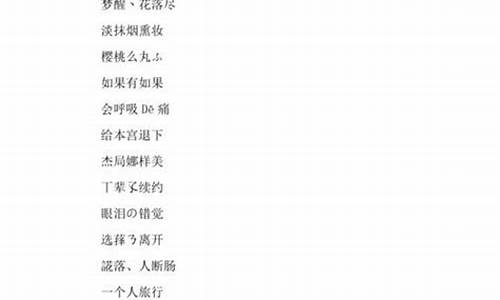emeritus_emeritus 翻译
大家好,今天我将为大家介绍一下关于emeritus的问题。为了更好地理解这个问题,我对相关资料进行了归纳整理,现在让我们一起来看看吧。
1.退休的,英语怎么翻译。
2.如何翻译中文称谓
3.Affiliated Faculty Emeriti Faculty 分别是什么意思
4.尊敬的教授 用英语怎么说啊?
5.美国最大的连锁养老运营公司Brookdale
6.柯奈尔·海门斯简介

退休的,英语怎么翻译。
retired英 [r?'tad]? 美 [r?'tad]?
adj. 退休的;退役的;幽闭的
v. 退休(retire的过去分词)
短语
1、Retired Emperor?太上皇
2、Retired stock?[金融]?已收回股份 ; 翻译
3、retired veterans?离休老干部 ; 离休人员 ; 军队离退休老干部 ; 离退休干部
4、BEFORE RETIRED?家务清官
5、retired donated?退休捐赠 ; 退休人士捐赠
6、Retired Judge?退休法官
7、retired pay?[军]?复员费 ;?[劳经]?退休金 ; 翻译
8、prematurely retired?早退休 ; 提前退休
9、retired allowance?[劳经]?退职金 ; 翻译
扩展资料
双语例句
1、He has retired from the army.?
他已经从部队退役。
2、Several college students boarded with the retired couple.?
几名大学生在一对退休夫妇家搭伙并寄宿。
3、When Mr. Green retired, his son took over the business from him.?
格林先生退休后,由他的儿子接管他的生意。
4、Some of the older workers were retired before time.?
有些年纪较大的工人不到年龄就被打发退休了。
5、We gave him 100 dollars to buy presents for the retired workers, but he pocketed most of it.?
我们给他一百美元为退休工人买礼物,但他私吞了一大半。
如何翻译中文称谓
政治学副教授宗教研究副教授法学院副教授法学院
美国正式的教授职称序列分为三个层次:助理教授(AssistantProfessor)、副教授(AssociateProfessor)与正教授(fullProfessor)。
在上述序列中,一般来说,只有到了副教授的时候,才能进入到“终身教职”的行列。
在美国,除了“正式的”序列之外,还有特殊的职称序列,如“荣誉退休教授”(ProfessorEmeritus)、“杰出教授”(DistinguishedProfessor)、“校聘教授”(UniversityProfessor)、“讲席教授”(Named/EndowedChair)等。这些都是更为高级、仅只授予在学术界作出了杰出贡献的少数顶尖学者的职称。这些“特殊序列”,同样属于“终身教职”的序列。
在美国,还有一些“非终身教职”的序列,如“讲师”(Lecturer/Instructor)、“访问教授”或者“访问讲师”、“兼职教授”(AdjunctProfessor)、“研究教授”(ResearchProfessor)、“名誉教授”(HonoraryProfessor)等。
Affiliated Faculty Emeriti Faculty 分别是什么意思
如何翻译中文称谓? 这个问题太广泛了。
称谓代表了一个人的职位、职衔或学衔,体现了一个人的资历和地位。称谓的误译不仅是对有关人员的不尊重,而且也会产生种种不良的后果。称谓的准确翻译其关键在于译员对有关人员的身份及其称谓的表达是否有一个正确的理解,尤其是对称谓语的认识。一种称谓语很可能表示多种身份,例如,英语的头衔语 president,译成汉语时可视具体情况分别译作共和国的总统、国家主席、大学的校长、学院的院长、学会或协会的会长或主席、公司的总裁或董事长等等。
一般说来,各类机构或组织的首长其汉语称谓译成英语时虽可套用通用词 head,但从比较严格的意义上看,应使用特定的、规范的称谓语。例如:
校长(大学) President of Beijing University
校长(中小学) Principal /Headmaster of Donghai Middle School
院长(大学下属) Dean of the Graduate School
系主任(大学学院下属) Chair/Chairman of the English Department
会长/主席(学/协会) President of the Student Union, Shanghai University
厂长(企业) Director of the Machine Tools Manufacturing Plant
院长(医院) President of Huadong Hospital
主任(中心) Director of the Business Center
主任(行政) Director of Foreign Affairs Office
董事长(企业) President/Chairman of the Board of Directors
董事长(学校) President/Chairman of the Board of Trustees
首席长官的汉语称谓常以“总……”表示,而表示首席长官的英语称谓语则常带有 chief general, head , managing 这类词,因此当翻译冠以“总”字的头衔时,需遵循英语头衔的表达习惯:
总书记 general secretary
总工程师 chief engineer
总会计师 chief accountant
总建筑师 chief architect
总编辑 chief editor; editor-in-chief; managing editor
总出纳 chief cashier; general cashier
总裁判 chief referee
总经理 general manager; managing director; executive head
总代理 general agent
总教练 head coach
总导演 head director
总干事 secretary-general;commissioner
总指挥 commander-in-chief; generalissimo
总领事 consul-general
总监 chief inspector; inspector-general;chief impresario
总厨 head cook; chef
有些部门或机构的首长或主管的英译,可以用一些通用的头衔词表示,例如下列机构的负责人可以用 director, head 或 chief 来表示:
司(部属)department
厅(省属)department
署(省属)office(行署为administrative office)
局 bureau
所 institute
处 division
科 section
股 section
室 office
教研室 program / section
例:
局长 director of the bureau; head of the bureau; bureau chief。
国务院 the State Council 属下的部为 ministry,所以部长叫作 minister。
另外,公署专员叫作commissioner,其办事机构叫作“专员公署”,英语为 prefectural commissioner's office。
汉语中表示副职的头衔一般都冠以“副”字,英译时需视词语的固定搭配或表达习惯等情况,可选择 vice, associate, assistant, deputy 等词。相对而言,vice 使用面较广,例如:
副总统(或大学副校长等)vice president
副主席(或系副主任等)vice chairman
副总理 vice premier
副部长 vice minister
副省长 vice governor
副市长 vice mayor
副领事 vice consul
副校长(中小学)vice principal
行政职务的副职头衔与学术头衔的“副”职称往往用不同的词表达,最为常用的英语词是 associate,例如:
副教授 associate professor
副研究员 associate research fellow
副主编 associate managing editor
副编审 associate senior editor
副审判长 associate judge
副研究馆员 associate research fellow of ... (e.g. library science)
副译审 associate senior translator
副主任医师 associate senior doctor
当然,有些英语职位头衔,如 manager 和 headmaster,其副职头衔可冠以 assistant,例如:
副总经理 assistant / deputy general manager; assistant / deputy managing director
大堂副理(宾馆)assistant manager
副校长(中小学)assistant headmaster
以 director 表示的职位的副职常以 deputy director 表示。此外,secretary, mayor, dean 等头衔的副职也可冠以 deputy,例如:
副秘书长 deputy secretary-general
副书记 deputy secretary
副市长 deputy mayor
副院长 deputy dean
学术头衔系列除了含“正”“副”级别的高级职称和中级职称外,还有初级职称如“助理”,“助理”常用 assistant 来表示,例如:
助理教授 assistant professor
助理研究员 assistant research fellow
助理工程师 assistant engineer
助理编辑 assistant editor
助理馆员 assistant research fellow of... (e.g. library science)
助理教练 assistant coach
助理农艺师 assistant agronomist
还有一些行业的职称头衔,其高级职称不用“正”或“副”表示,而直接用“高级”或“资深”来表示,我们可以用 senior 来称呼,例如:
高级编辑 senior editor
高级工程师 senior engineer
高级记者 senior reporter
高级讲师 senior lecturer
高级教师 senior teacher
高级农艺师 senior agronomist
有一些行业的职称或职务系列中,最高级别的职位冠以“首席”一词,英语常用 chief 来表示:
首席执行官 chief executive officer (CEO)
首席法官 chief judge
首席顾问 chief advisor
首席检察官 chief inspector / prosecutor
首席仲裁员 chief arbitrator
首席监事 chief supervisor
首席播音员 chief announcer / broadcaster
首席代表 chief representative
首席记者 chief correspondent
除了用“总”、“高级”、“首席”等词语来表示一些机构或行业的最高级职务之外,还有一些高级职务则使用带“长”字的头衔,例如:
检察长 procurator-general
审判长 presiding judge;chief judge;chief of judges
护士长 head nurse
秘书长 secretary-general
参谋长 chief of staff
厨师长 head cook,chef
有些头衔会含诸如“代理”、“常务”、“执行”、“名誉”这类称谓语,例如:
代理市长,代理总理,代理主任
常务理事,常务副校长
执行主席,执行主任,执行秘书
名誉校长,名誉会长
一般说来,“代理”可译作 acting,例如:
代理市长 acting mayor
代理总理 acting premier
代理主任 acting director
“常务”可以 managing 表示,例如:
常务理事 managing director
常务副校长 managing vice president(亦可作 first vice mayor)
“执行”可译作 executive,例如:
执行主任executive director
执行秘书executive secretary
执行主席executive chairman(也可译作presiding chairman)
“名誉”译为honorary,例如:
名誉校长 honorary president / principal
名誉主席、会长 honorary chairman / president(也可用 emeritus 表示,如 emeritus chairman / president)
有些职称或职务带有“主任”、“主治”、“特级”厂特派,、“特约”等头衔,英译不尽相同,例如:
主任编辑 associate senior editor
主任秘书 chief secretary
主任医师 senior doctor
主任护士 senior nurse
主治医师 attending / chief doctor; physician; consultant
特级教师 special-grade senior teacher
特派记者 accredited correspondent
特派员/专员 commissioner
特约编辑 contributing editor
特约记者 special correspondent
许多职称、职务的头衔称谓其英语表达法难以归类,需要日积月累,逐步登录在自己的称谓语料库中。以下所列举是其中的一部分:
办公室主任 office manager (如“校长办公室主任” manager of president's office)
财务主任 treasurer
车间主任 workshop manager / director
编审 senior editor
博导(博士生导师)doctoral student supervisor
研究生导师 graduate student tutor
客座教授 visiting professor
院士 academician
译审 senior translator
村长 village head
领班 captain;foreman;gaffer
经纪人 broker
税务员 tax collector
研究管员 research fellow of...(如“图书馆研究管员” research fellow of library science)
股票交易员 stock dealer
红马夹 (stock exchange) floor broker
业务经理 service/business/operation manager
住院医生 resident (doctor); registrar
国际大师 international master
注册会计师 chartered / certified public accountant; registered / incorporated accountant
我国有一些常见的荣誉称号 (honorary title) 在许多英语国家没有对应的表达语,现列举部分英译供参考:
标兵 pacemaker
学习标兵 student pacemaker; model student
劳动模范 model worker
模范教师 model teacher
优秀教师 excellent teacher
优秀员工 outstanding employee; employee of the month / year
青年标兵 model youth / youth pacemaker
三好学生 "triple-A" outstanding student; outstanding student
三八妇女红旗手 "March 8th Red Banner" outstanding woman pacemaker
我打了这半天手都累了,请采纳。
尊敬的教授 用英语怎么说啊?
Affiliated Faculty 是附属学院或教职
Emeriti Faculty 是终身或荣誉教职 如 professor emeritus 是荣誉或终生教授
这里的faculty 不是学院,问世教职的意思 faculty member 是学院教职
美国最大的连锁养老运营公司Brookdale
尊敬的教授用英语说为:Dear Professor一、dear
dear? 英 [d?(r)] 美 [d?r]?
adj. 亲爱的;敬爱的;昂贵的;严厉的。
n. 亲爱的人;宠物。
int. 哎。
adv. 贵;高价地;疼爱地。
二、Professor
professor? 英 [pr?fes?(r)] 美 [pr?f?s?]?
n. 教授;大学讲师,教员;自称者,宣称者。
扩展资料:
与dear相似的单词:
一、darling
darling? 英 [?dɑ:l?] 美 [?dɑ:rl?]?
n. 亲爱的;心爱的人;倍受宠爱的人;亲切友好的的人。
adj. 倍受喜爱的,可爱的,迷人的。
二、honey
honey? 英 [?h?ni] 美 [?h?ni]?
n. 蜂蜜;宝贝;可爱的人
adj. 蜜的;心爱的;加了蜜的。
三、sweetheart
sweetheart 英 [?swi:thɑ:t] 美 [?swi:thɑ:rt]?
n. 情人,爱人
vi. 爱慕
参考资料:
柯奈尔·海门斯简介
@ #案例 #商业模式 #养老Brookdale—— Brookdale高级养老公司是全美最大的高级养老服务公司,成立于1978年,总部位于田纳西州布伦特伍德,主营老年住宅,专门面向高收入和中高收入的消费者,为他们提供积极的退休生活和高质量的个人服务。Brookdale于1997年5月2日在美国纳斯达克上市。目前,Brookdale在47个州拥有1100多个养老社区,覆盖全美百分之八十的人口,有接近8万员工,服务对象超过10万人。公司运营的服务类型,主要包括生活自理型社区、生活协助型社区、特殊护理(老年痴呆护理)社区,以及持续护理退休社区。
——2005年6月,Brookdale公司和Alterra医疗保健公司合并,Alterra当时在养老行业也是名列前茅的公司,并于11月公开上市募股。
——2006年7月,Brookdale宣布并购田纳西州那什维尔的美国退休公司(AmericanRetirement Corporation,ARC)。ARC当时在全美运营着接近130家社区,ARC从20世纪70年就开始运营,业务范围从CCRC到协助型社区到自理型社区都有涉及。Fortress认为合并ARC对于Brookdale来说是一个把它推向行业前列的好机会,不仅仅是为了扩大规模,而是把行业中运营时间最长的和最成功的养老公司联合起来,完成对ARC公司的并购后,Brookdale在36个州拥有接近550个社区。
——2009年10月,Brookdale养老公司和Sunrise养老公司达成协议,Brookdale获得Sunrise公司的21家养老社区。
——2011年10月,Brookdale完成对Horizon Bay Retirement Living公司的收购,获得其在全美近90家养老社区。
——2014年7月底,Brookdale完成对Emeritus养老公司的收购,Emeritus当时是全美第二大养老公司。至此,Brookdale成为全美唯一一家全方位的高级养老解决方案公司,在46个州拥有1100多家养老社区,覆盖全美80%的人口。对于Emeritus公司的并购,对于Brookdale公司来说意义非凡,不但使得它成为全美最大的养老公司,社区数量猛增493个,业务范围迅速扩大到47个州,对于其品牌的推广建设意义也同样重大。
截止到2015年底,Brookdale自营和租用养老社区959个、单元81067个;为164个社区、27353个单元提供管理运营服务。从社区类型来看,Brookdale运营130个退休中心社区(24486个单元)、915个协助型社区(62567个单元)、78个CCRCs持续护理退休社区(21367个单元)。Brookdale的社区大多数都在校园驻地或者配套设施比较完善的社区周边。
截止到2015年底,公司的收入构成,38.8%来自于自有社区的用户居住和管理费用,48.7%来源于租赁社区,11.1%来自Brookdale的配套服务,1.4%来自于为第三方公司提供的管理服务费用。
在企业的营业收入和利润方面,根据Brookdale Senior Living公司在2016年2月16日公布的2015年度财务报表,如图表所示:(数据来源MarketWatch)
从图表可以清晰反应出Brookdale近几年的经营状况,从2011年到2014年,虽然营业收入一直在上升,但是利润率增长缓慢,甚至出现过2013年到2014年度的负增长。受2014年收购美国第二大养老服务公司Emeritus之后,业绩得到了短时间内迅速上升。虽然已经成为美国最大的养老公司,结合之前的数据,其盈利能力还有待提升。
图:养老护理内容分布
1.退休中心社区
这种社区专门为75或以上的中高层收入的老年人提供高质量的养老服务。一般一个退休中心社区,包括自理型和辅助型单元,可以因地制宜的根据不同的单元和用户情况为用户提供自理型或者辅助性服务。截止到2015年底,78.9%的退休社区的单元是自理型单元,剩下的为辅助性单元。
退休社区包含了Brookdale自有和租赁的社区,以及他们为第三方或者合资企业提供服务的退休社区。截止到2105年底,Brookdale的退休中心业务板块有95个退休中心社区,17140个单元,占Brookdale公司整个社区容量的15.8%;为35个社区,7346个单元提供管理服务,占Brookdale公司整个社区容量的 6.8%。这些退休社区占Brookdale公司整个社区容量的22.6%。
2.协助型社区
Brookdale的协助型社区为居民提供住房、为日常活动需要24小时协助的居民,以及年级较大身体较弱的居民提供服务。协助型社区为客户提供独立式单层住房和多层住房,所有的都有超过50张床位,较小的多层或者独栋有的床位少于50张。
在协助型社区中还包含了记忆护理社区,这些独立的辅助生活社区专为有阿尔茨海默氏症的居民和其他患有痴呆认知能力在不断下降,需要照料的居民,以保证他们有一定的生活质量。记忆护理社区有14至69张病床,有些是按照学校标准配置,包括一个独立的辅助生活社区。
截至2015年底,辅助生活社区有820个,53504套房间,占Brookdale公司整个社区容量的49.3%;参与管理服务的社区95个,9063套房间,占Brookdale公司整个社区容量的8.4%。这些辅助型社区占Brookdale公司整个社区容量的57.7.%。其中571个社区,14077个单元提供记忆护理服务。
3.CCRCS(持续护理退休社区)
Brookdale的CCRCS社区是大型社区,提供各种生活安排和服务,以适应各个层面的身体状况和健康。大多数CCRCs包涵自理生活型、协助生活型和专业护理社区服务,有一部分社区也有记忆护理(阿尔茨海默护理)服务。
CCRCs社区包括租赁的CCRCs以及公司管理运营的第三方CCRCS社区。截至2015年底,Brookdale拥有44个CCRCs 社区,10423个单元,占Brookdale公司整个社区容量的9.6%;34 个社区、10944个单元为公司参与管理运营,占Brookdale公司整个社区容量的10.7%。这些CCRCS社区占Brookdale公司整个社区容量的19.7%。
截至2015年12月31日,租赁部分的CCRCS社区,包含3个“入场费”CCRCS社区,1172个单元和Brookdale公司参与管理的17个“入场费”CCRCs、8152个单元,占据Brookdale公司整个社区容量的8.1%。
4.Brookdale辅助性服务(配套服务)
Brookdale的辅助性服务目前为社区居民提供家庭保健、治疗、教育和健康计划等服务。这些项目主要集中在健康和身体素质上,目的是让居民保持最大程度的独立。
在医疗服务方面,主要提供身体、与职业相关、语言上的治疗和家庭健康服务。家庭健康服务根据需要提供包括专业护理、物理治疗、职业治疗、言语治疗、庭健康助手服务和社会服务在内的服务。另外,Brookdale也在某些地区提供临终关怀服务。相对于其他竞争者来说,Brookdale的辅助性服务因其在业内的地位和丰富的经验,有着得天独厚的优势。
5.管理运营服务
Brookdale公司管理的社区有一些是第三方机构或者未合并的合资企业所有的,但是Brookdale公司享有所有权权益。在管理运营协议下管理这些社区,根据提供的服务收取相应的服务管理费用。
截止到2015年底,Brookdale为164家社区、27353套房屋提供管理服务,这占其公司总社区容量的25.3%。其中22家社区、2211套房屋是第三方所有;142个社区、25142套单元归合资企业所有。这些社区构成了上述中的35家退休社区、95家协助型社区和34家CCRCs社区。
Brookdale已经成为全美最大的养老公司, 14年之前利润增速缓慢,甚至一度出现负增长。在收购Emeritus公司之后,利润增长率超过了10%。但是,收入的增加依然是这家上市公司的首要问题:
第一,在控制运营成本的同时,提高社区入住率、提高社区月度服务费用。 Brookdale公司计划通过不断的提高优化社区运营,加大市场营销的执行力度来保持公司的增长。为此,Brookdale创建了一个多层次的营销体系,通过全国、各地区和地方市场活动集合利用呼叫中心资源来平衡利用互联网和公司反应机制。另外,这个营销体系还可以利用Brookdale在2013年发起了Brookdale品牌创新活动,来扩大自己的营销影响力。同时,借助合并Emeritus的良好势头,努力提供公司的运行效率,降低运营成本。
第二,通过战略性资金分配提高公司收入。 Brookdale计划把一部分资金投入到现有社区的增值完善上面,比如对社区的重建和改造,对有些社区的重新规划和定位,最大程度的发挥每个社区的优势,以此来提高社区的吸引力,提高社区入住率;另一方面,在合适的时候,Brookdale公司会有选择性的收购现有的运营公司、各种组合投资、家庭保健机构和高级养老社区等公司来扩大自身规模。同时,对于Brookdale公司目前租用和管理的养老社区也会考虑并购,以加强资源整合,收购的战略重点还是集中放在可以对公司市场有重要补充作用的产品上。
第三,提高品牌影响力,着力培养Brookdale的品牌影响力。 Brookdale计划打造一个辨识度较高的全国性品牌,通过提升社区入住率和增长路来创造市场的差异化,提升自身品牌价值。作为国内最大的养老服务商,市场范围覆盖全国,产品服务多样化,这给了Brookdale足够的优势去成为美国国内养老行业的领导者和养老问题方案提供商。Brookdale公司希望通过调整、整个市场营销活动以及品牌创新会使更多的用户认可Brookdale这个品牌,形成品牌忠诚度,不仅仅是对于用户,还有合作商和公司需要的人才。
第四,创新产品服务,包括Brookdale的配套服务项目。 Brookdale希望通过创新产品形式,提供新的养老生活解决方案来不断满足客户的需求。Brookdale计划为现有客户提供更多新的服务形式,并此来开发新客户。加上Brookdale的配套服务,目前公司可以提供治疗、家庭保健、临终关怀等配套附属服务、教育和相应的健康计划服务。Brookdale希望不单单在他们所有的养老社区中提供这些服务,他们计划把这些服务推广到那些希望在自己家中度过晚年的用户,让自己的产品服务走出社区,为更多需要的人服务。他们希望以此能在后续医疗保健领域能够占有一席之地,为用户提供更加全面的养老解决方案。
Brookdale—— 从1978成立,到1997年上市至今,Brookdale期间通过不断的兼并其他同行业公司,完成了到今天成为美国最大的养老公司的转变,其发展模式不亚于一部壮阔的行业兼并史。Brookdale在完成自身蜕变的同时,也大大促进了美国养老行业的发展,其创新精神和行业模式的拓展精神值得当今各个行业公司的学习。
Brookdale发展至今,其规模和行业地位已经无人能及,然而从起经营战略来看,其发展扩大的脚步并未停止。在拥有自理型养老社区、协助型养老社区、退休中心和CCRC等一系列行业比较全面的服务模式之后,其产品服务的开拓之路仍未停止。
在Brookdale公司2015年年报中,仍然提出了在控制运营成本的同时,提高社区入住率、提高社区月度服务费用;通过战略性资金分配提高公司收入;提高品牌影响力,着力培养Brookdale的品牌影响力;创新产品服务,特别是Brookdale的配套服务项目等四项具体的措施来推动企业的往前发展。目前,Brookdale养老公司以空前的规模和实力牢牢占据美国养老市场的一大部分份额,其他养老公司要想追赶并超越实属不易。
来源
目录 1 拼音 2 诺贝尔生理学或医学奖获奖原因 3 柯奈尔·海门斯生平 1 拼音
kē nài ěr ·hǎi mén sī
柯奈尔·海门斯 (Corneille Jean Fran?ois Heymans,1892年-1968年),比利时医学家,因发现了颈动脉窦和主动脉弓调节呼吸的作用,于1938年获得诺贝尔生理学或医学奖。
2 诺贝尔生理学或医学奖获奖原因“发现窦和主动脉机制在呼吸调节中所起的作用”
"for the discovery of the role played by the sinus and aortic mechani *** s in the regulation of respiration"
3 柯奈尔·海门斯生平柯奈尔·海门斯1892年3月28日出生在比利时根特。他的父亲J. F. Heymans是原根特大学药理学教授和校长、该校药理学和治疗学的创始人。1920年,海门斯在根特大学拿到博士学位。之后开始在法兰西学院、洛桑大学、维也纳大学、伦敦大学和凯斯西储医学院任职。
Corneille Jean Fran?ois Heymans was born in Ghent, Belgium, on March 28, 1892. His father was J. F. Heymans, formerly Professor of Pharmacology and Rector of the University of Ghent, who founded the J. F. Heymans Institute of Pharmacology and Therapeutics at the same University.
Corneille received his secondary education at the St. Lievenscollege (Ghent), St. Jozefscollege (Turnhout), and St. Barbaracollege (Ghent). He had his medical education at the University of Ghent, where he obtained his doctor's degree in 1920. After his graduation he worked at the Collège de France, Paris (Prof. E. Gley), University of Lausanne (Prof. M. Arthus), University of Vienna (Prof. H. H. Meyer), University College of London (Prof. E. H. Starling) and Western Reserve Medical School (Prof. C. F. Wiggers).
In 1922 he became Lecturer in Pharmacodynamics at the University of Ghent. In 1930 he succeeded his father as Professor of Pharmacology, being also appointed Head of the Department of Pharmacology, Pharmacodynamics, and Toxicology; at the same time he became Director of the J. F. Heymans Institute. He is Professor Emeritus since 1963.
The scientific investigations carried out at the Heymans Institute are mainly directed towards the physiology and pharmacology of respiration, blood circulation, metaboli *** , and numerous pharmacological problems. These studies led, in particular, to the discovery of the chemoreceptors, situated in the cardioaortic and carotid sinus areas, and also to contributions regarding the proprioceptive regulation of arterial blood pressure and hypertension. The discovery of the reflexogenic role of the cardioaortic and the carotid sinus areas in the regulation of respiration, above all, earned C. Heymans the Nobel Prize in 1938.
Another series of investigations by Heymans and his collaborators was devoted to the physiology of cerebral circulation and of the physiopathology of arterial hypertension of nervous and renal origin; also to the study of blood circulation during muscular exercise; to the physiology and pharmacology of animals totally sympathectomized; to the study of the survival and revival of different nervous centres after the arrest of blood circulation; to the pharmacology of stimulating substances of cellular metaboli *** , to the pharmacology of the lungs and many other problems.
A prolific author, Heymans has since 1920 issued about 800 papers, published in different periodicals. The results of his investigations have been mainly reported by him in the following general publications: Le Sinus Carotidien et les autres Zones vasosensibles réflexogènes (1920); Le Sinus Carotidien et la Zone Homologue Cardioaortique, with J. J. Bouckaert and P. Regniers (1933); Sensibilité réflexogène des vaisseaux aux excitants chimiques, with J. J. Bouckaert (1934); ?Le centre respiratoire?, with D. Cordier in Ann. Physiol. Physicochim., II (1935) 335; ?Survival and revival of nerve centers after arrest of circulation?, Physiol. Rev., 30 (1950) 375; ?New ects of blood pressure regulation?, with G. van den Heuvel, Circulation, 4 (1951) 581;?Pharmakologische Wirkungen auf die Selbststeuerung des Blutdruckes?, Arch. Exp. Pathol. Pharmakol., 216 (1952) 114; ?Action of drugs on carotid sinus and body?, Pharmacol. Rev., 7 (1955) 119; Reflexogenic Areas of the Cardiovascular System, with E. Neil (1958), ?Vasomotor control and the regulation of blood pressure?, with B. Folkow, in Circulation of the BloodMen and Ideas, edit. by A. P. Fishman and D. W. Richards.
Heymans is publisher and EditorinChief of the Archives Internationales de Pharmacodynamie et de Thérapie, founded in 1895 by his father and Professor E. Gley, Paris.
From 1945 to 1962 Heymans has lectured at numerous universities in Europe, North and South America, Africa, and Asia. He was in 1934 ?Herter Lecturer? at the University of New York; and in 1937 he was ?Lecturer of the Dunham Memorial Foundation? at Harvard University, as well as ?Hanna Foundation Lecturer? at the Western Reserve University, and ?Greensfelder Memorial Lecturer? at the University of Chicago. In 1939 he was ?Lecturer of the Purser Memorial Foundation? at Trinity College, University of Dublin.
Commissioned with special missions by the Belgian Government, the International Union of Physiological Sciences, and by the World Health Organization, he has travelled to Iran and India (1953), Egypt (1955), the Belgian Congo (1957), Latin America (1958), China (1959), Japan (1960), Iraq (1962), Tunisia (1963), Cameroun (1963).
He has been President of the International Union of Physiological Sciences and of the International Council of Pharmacologists and has presided over the 20th International Congress of Physiology held in Brussels in 1956. His vast knowledge of pharmacology has justified his nomination as Member of the Committee of Experts of the International Pharmacopoeia of the World Health Organization. In his own country he is VicePresident of the National Council on Scientific Policy.
Heymans is Member or Honorary Member of a large number of leading scientific societies concerned with physiology or medicine in Europe and in North and South America, including the Pontificia Academia Scientiarum, the Royal Society of Arts of Great Britain, the Académie des Sciences de Paris (Institut de France), Académie de Médecine de Paris, the Heidelberger Akademie für Wissenschaften, and the New York Academy of Sciences. He has been appointed Professor honoris causa of the University of Montevideo, and doctor honoris causa of the Universities of Utrecht, Louvain, Montpellier, Torino, Santiago de Chile, Lima, Bogotá, Rio de Janeiro, Algiers, Paris, Montpellier, Münster, Bordeaux, Toulouse, and Geetown University, Washington.
Besides the Nobel Prize, his scientific awards include the Alvarenga Prize of the Académie Royale de Médicine de Belgique, the Gluge Prize of the Académie Royale des Sciences de Belgique, the Quinquennial Prize (19311935) for Medicine of the Belgian Government, the ?Alumni? Prize for Medicine of the Belgian University Foundation, the Bourceret Prize of the Académie de Médecine de Paris (1930), the Monthyon Prize of the Institut de France (1934), the Pius XI Prize of the Pontificia Academia Scientiarum (1938), the Burgi Prize of the University of Bern and the de Cyon Prize (1931) of the University of Bologna, etc.
Heymans is Officer in the Order of the Crown with Swords, Grand Officer in the Order of the Polar Star (Sweden), Grand Officer of the Order of Leopold, Commander in the Order of St. Sylvester (Vatican City), Commander in the Knightly Order of the Holy Sepulchre of Jerusalem; other distinctions include the Civilian Cross (First Class) for Distinguished Services Rendered to the Fatherland, the Belgian War Cross 19141918, the Fire Cross with 8 bars 19141918. (He was Field Artillery Officer during the first World War. )
Professor Heymans married Berthe May, M. D. in 1921. There are four children by the marriage: MarieHenriette, Pierre, Jean, and Berthe; and 18 grandchildren. He loves painting and is greatly interested in ancient literature dealing with the history of medicine; he is also a keen hunter.
From Nobel Lectures, Physiology or Medicine 19221941, Elsevier Publishing Company, Amsterdam, 1965
This autobiography/biography was written at the time of the award and first published in the book series Les Prix Nobel. It was later edited and republished in Nobel Lectures. To cite this document, always state the source as shown above.
Corneille Heymans died on July 18, 1968.
好了,关于“emeritus”的话题就讲到这里了。希望大家能够对“emeritus”有更深入的了解,并且从我的回答中得到一些启示。
声明:本站所有文章资源内容,如无特殊说明或标注,均为采集网络资源。如若本站内容侵犯了原著者的合法权益,可联系本站删除。












